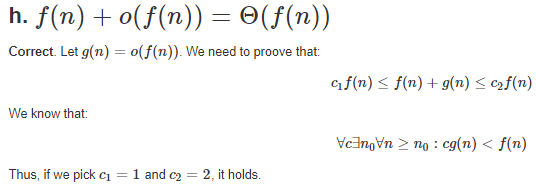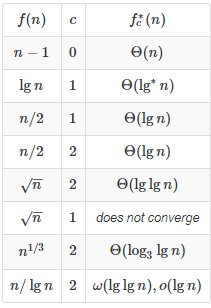2020/10/28:初稿,参考https://ita.skanev.com/,修订参考文献的部分错误
2020/10/30:修订第二节第4题的证明错误(参考https://blog.csdn.net/qq_36414798/article/details/81028403)
3 Growth of Functions
3.1 Asymptotic notation
1.Let f(n) + g(n) be asymptotically nonnegative functions. Using the basic definition of Θ-notation, prove that max(f(n),g(n))=Θ(f(n)+g(n)).
From asymptotically nonnegative, we can assume that:

Let  , some obvious things for
, some obvious things for  :
:

From the last two inequalities, we get:

Which is the definition of with
with 
2.Show that for any real constants a and b, where b>0,

The most significant term is  and this is obviously polynomially tightly bound.
and this is obviously polynomially tightly bound.
3.Explain why the statement, "The running time of algorithm A is at least  is meaningless.
is meaningless.
The O-notation provides an upper bound. "At least" implies a lower bound.
4.Is  ? Is
? Is 
Yes, because if we choose 2 for both constants in the O-notation definition, we get an equality.
No, because 
5.Prove Theorem 3.1
The theorem states:
For any two functions f(n) and g(n), we have f(n)=Θ(g(n)) if and only if f(n)=O(g(n)) and f(n)=Ω(g(n))

6.Prove that the running time of an algorithm is Θ(g(n)) if and only if its worst-case running time is O(g(n)) and its best-case running time is Ω(g(n)).

7.Prove o(g(n))∩ω(g(n)) is the empty set.

8.We can extend our notation to the case of two parameters n and m that can go to infinity independently at different rates. For a given function g(n,m) we denote O(g(n,m)) the set of functions:

Give corresponding definitions for Ω(g(n,m)) and Θ(g(n,m)).

3.2 Standard notations and common functions
1.Show that if f(n) and g(n) are monotonically increasing functions, then so are the functions f(n)+g(n) and f(g(n)), and if f(n) and g(n) are in addition nonnegative, then f(n)⋅g(n) is monotonically increasing.

2.Prove equation (3.16)

3.Prove equation (3.19). Also prove that n!=ω( ) and n!=o(
) and n!=o( ).
).

4.Is the function ⌈lgn⌉! polynomially bounded? Is the function ⌈lglgn⌉! polynomially bounded?
⌈lgn⌉! is not polynomially bounded, but ⌈lglgn!⌉ is.
If we take the definition of polynomially bound:
and take the logarithm of each side, we get:

Thus, a function is polynomially bound if 
In the following proofs, we will make use of the following two facts:
lg(n!) = Θ(nlgn) (by equation (3.19))
⌈lgn⌉ = Θ(lgn), because
· ⌈lgn⌉ ≥ lgn
· ⌈lgn⌉ ≤ lgn + 1 ≤ 2lgn, for all n ≥ 2
lg(⌈lgn⌉!) = Θ(⌈lgn⌉lg⌈lgn⌉) = Θ(lgn lg lgn) = ω(lgn).Therefore, lg(⌈lgn⌉!) ≠ Ο(lgn), and so ⌈lgn⌉! is not polynomially bounded.
lg(⌈lglgn⌉!) = Θ(⌈lglgn⌉lg⌈lglgn⌉) = Θ(lglgn lg lglgn) =  =
=  = ο(lgn) .
= ο(lgn) .
The last step above follows from the property that any polylogarithmic function grows more slowly than any positive polynomial function, i.e., that for constants a, b > 0, we have  =
=  . Substitute lgn for n, 2 for b, and 1 for a, giving
. Substitute lgn for n, 2 for b, and 1 for a, giving .
.
Therefore, lg(⌈lglgn⌉!) = Ο(lgn), and so ⌈lglgn⌉! is polynomially bounded.
5. Which is asymptotically larger:
The second, because:

6.Show that the golden ratio ϕ and its conjugate  both satisfy the equation
both satisfy the equation  .
.

7.Proove by induction that the ith Fibonacci number satisfies the equality

Base:


Step:

8.Show that  implies
implies  .
.

Problem
3.1 Asymptotic behavior of polynomials

3.2 Asymptotic behavior of polynomials
Indicate for each pair of expressions (A,B) in the table below, whether A is O, o, Ω, ω, or Θ of B. Assume that k≥1, ϵ>0, and c>1 are constants. Your answer should be in the form of the table with "yes" or "no" written in each box.

Note:
3.3 Ordering by asymptotic growth rates.
a.Rank the following functions by order of growth;that is, find an arrangement  of the functions
of the functions  . Partition your list into equivalence classes such that functions f(n) and g(n) are in the same class if and only if
. Partition your list into equivalence classes such that functions f(n) and g(n) are in the same class if and only if  .
.
b.Give an example of a single nonnegative function f(n) such that for all functions gi(n) in part (1), f(n) is neither  nor
nor  .
.


The order is thus:

The asked function can be:
3.4 Asymptotic notation properties




3.5 Variations on O and Ω


3.6 Iterated functions



























 9028
9028

 被折叠的 条评论
为什么被折叠?
被折叠的 条评论
为什么被折叠?








